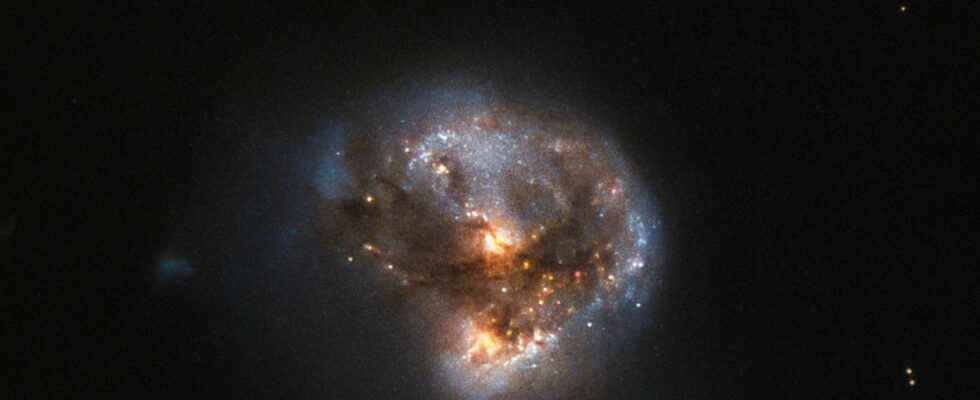An international team of radio astronomers led by a researcher from the Curtin University in Australia submitted an article on Arxiv in which she announces that she has identified the most distant laser known cosmic, a megamaser probably produced by a collision of galaxies. The photons masers produced have traveled for about 5 billion years to join the antennas of the network of radio telescopes named MeerKAT and located in South Africa.
Let us insist on the fact that the source undergoes indeed, strictly speaking, a maser effect and not a laser one. In both cases, however, these are the consequences of the same effect. physical predicted in 1917 by Albert Einstein when he succeeded in deducing the law of the black body discovered by Max Plank in 1900 and which was at the origin of the quantum revolution, from the model of thebohr atom. Einstein was then led to postulate that in addition to the process of excitation of an atom by light causing it to absorb a photon, which caused a electron on a higher energy level in the Bohr atom, light could lead to cause the opposite effect, namely a transition to a lower state between the discrete energy states of the Bohr atom. We therefore speak about this effect ofstimulated emissionand this is the principle of the laser.
What is a laser? How can we make one? Who created the first laser? Are there different types of laser? Julien Totems, Lidar research engineer at the CEA’s Climate and Environmental Sciences Laboratory, answers all these questions and explains the possible applications of lasers in the field of the environment. This video is taken from the video game The Quantum Prisoner. © CEA Research
However, this effect has not really been put into practice by physicists that in 1953, when Charles H. Townes made the first microwave amplifier, a device operating on similar principles to the laser, but based on microwaves rather thaninfrared or visible radiation. This first maser (Microwave Amplification by Stimulated Emission of Radiation, or microwave amplification by stimulated emission of radiation) did not work continuously. It was the Russian physicists Nikolay Basov and Aleksandr Prokhorov who would solve this problem shortly afterwards, obtaining the Nobel prize with Townes in 1964.
A maser a thousand times brighter than the Sun
It was only following the realization of the first maser that the path leading to that of the first laseracronym for Light Amplification by Stimulated Emission of Radiation (in French, light amplification by stimulated emission of radiation), therefore operating in the visible light range. The performance was the work in 1960 of the physicist Theodor Maiman.
The maser effect can occur on a galactic scale and is then referred to as megamaser. But, on a smaller scale, we are talking about masers astrophysics. We know of several examples of regions in the Milky Way which are places of a maser effect, but with megamasers it is a question of a phenomenon 100 million times brighter, with a brightness total of the order of 1,000 times that of the Sun.
Researchers have discovered astrophysical masers since 1965, first associated with molecules hydroxylated (OH), then to molecules of water and carbon monoxide silicon. They were in the Milky Way but in 1973, the astronomers found one in NGC 253 and eventually the first megamaser in the Arp 220 galaxy. Over 200 megamasers are known to date.
The principle is the same as in the material medium where radiation amplification occurs. A population of atoms or molecules is excited to an energy level higher than that of its ground statefor example during a galactic collision which will heat the gas in galaxies. The return to the ground state spontaneously of part of this population will then produce a wave which will stimulate avalanche emission from other quantum systems.
The megamaser observed by MeerKAT, South Africa, is produced by hydroxyl OH radicals. It is the first of its kind discovered by this instrument in addition to being the most distant known to date. The astrophysicists baptized him “Nkalakatha” [prononcé ng-kuh-la-kuh-tah] – a word in the isiZulu language meaning “big boss”. MeerKAT is also studying its source galaxy with the line 21 cm from thehydrogen atomic and by combining these two signals, astrophysicists will learn more about the galaxy that hosts this megamaser and, ultimately, the evolution of galaxies in the observable cosmos.
The network of radio telescopes MeerKAT, in South Africa, also makes it possible to continue the detection of radio emissions from an extraterrestrial civilization within the framework of the Seti program. To obtain a fairly accurate French translation, click on the white rectangle at the bottom right. The English subtitles should then appear. Then click on the nut to the right of the rectangle, then on “Subtitles” and finally on “Translate automatically”. Choose “French”. © BerkeleySETI
Interested in what you just read?
